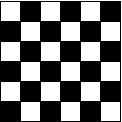
PROBLEM OF THE MONTH
SOLUTION
November, 2003
Jonathan Inbal provided the following solution:
THEOREM:An n x n square can be cut into "T" tetraminos if and only if n is divisible by 4.
In particular, a 10 x 10 square cannot be cut into "T" tetraminos.
PROOF: First, notice that a 4 x 4 square can be made out of "T" tetraminos as follows:

Conversely, assume that the square can be cut into "T" tetraminos. Since each tetramino consists of 4 squares, the square must be cut into n2/4 tetraminos. Since this number must be an integer, n2 is divisible by four which implies that n is divisible by 2. Now, color the squares black and white in a checkerboard pattern


This proof can be modified to provide some information in the case of an m x n rectangle. It can be shown that a necessary condition for the rectangle to be cut into "T" tetraminos is that the area, mn, must be divisible by 8. However, this condition is not sufficient, since a 1 x 8 rectangle can clearly not be subdivided. A sufficient condition is that both m and n be divisible by 4. Mr. Inbal has conjectured that this condition is also necessary. It would be interesting to try to prove his conjecture.